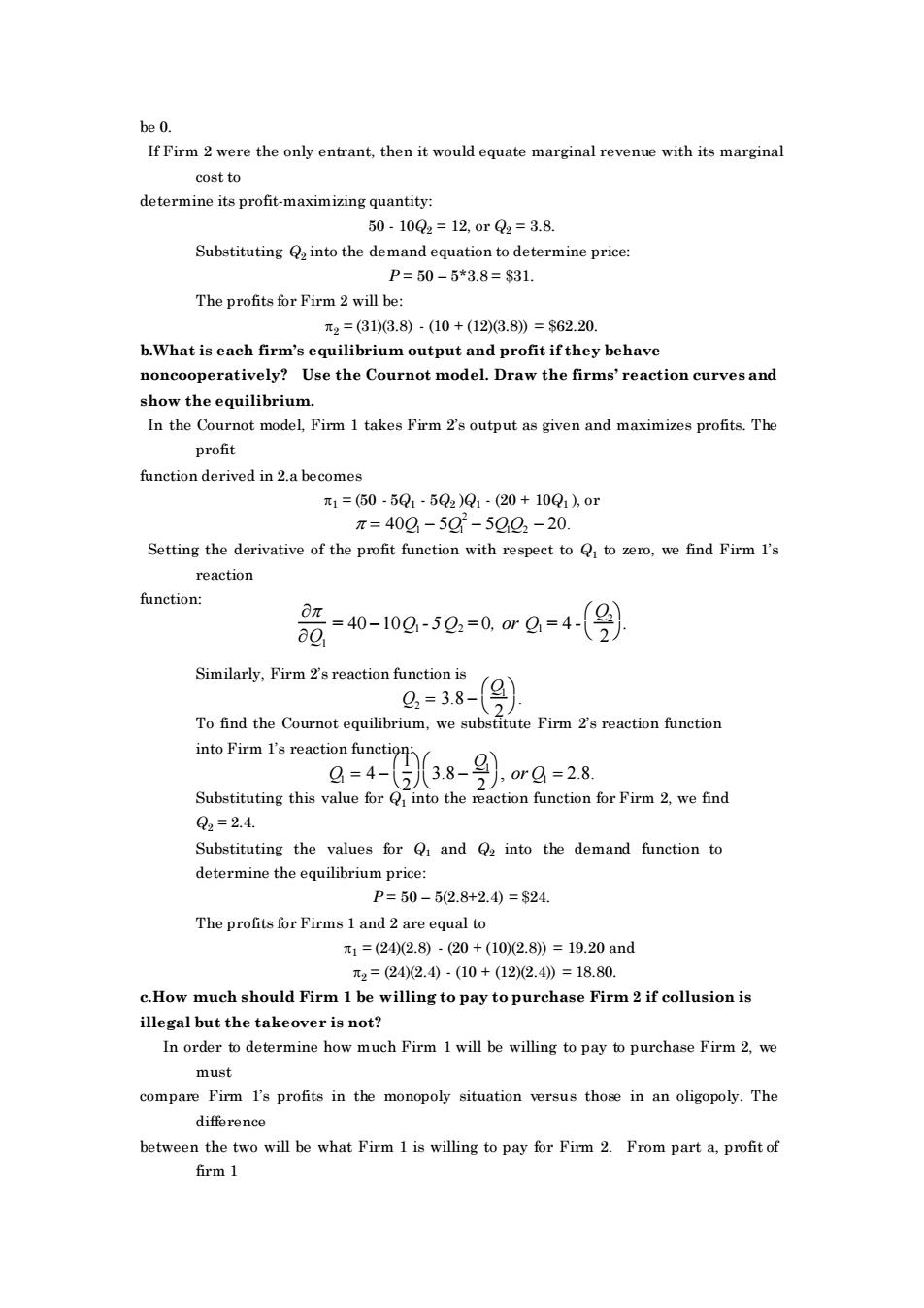正在加载图片...

If Firm 2 were the only entrant,then it would equate marginal revenue with its marginal cost to determine its profit-maximizing quantity: 50-10Q2=12,orQ2=3.8 Substituting into the demand equation to determine price: P=50-5*3.8=$31. The profits for Firm 2 will be: 2=313.8)-10+(123.8》=62.20 b.What is each firm's equilibrium output an profit if they behave noncooperatively?Use the Cournot model.Draw the firms'reaction curves and show the equilibrium. In the Cournot model Firm 1 takes Firm 2's output as given and maximizes profits.The profit function derived in 2.a becomes π1=(50-5Q1-5Q2)Q1-(20+10Q1),0r π=40g-5g-5Q2-20. Setting the derivative of the pfit function with respect find FirmI's reaction function: ag, 40-10e-50=-0r2=4-(9》 Similarly,Firm 2s reaction function is 02=3.8- To find the Cournot equilibrium,we substitute Firm 2's reaction function into Firm I's reaction func =4- 38- ,orQ=2.8 Substituting this value for into the reaction function for Firm 2.we find 22=2.4. Substituting the values for and into the demand function to determine the equilibrium price: P=50-5(2.8+2.4)=$24 The profits for Firms 1 and 2 are equal to 1=(242.8)(20+(102.8=19.20and 元2=(2402.4)-(10+(122.4)=18.80 c.How much should Firm 1 be willing to pay to purchase Firm 2 if collusion is illegal but the takeover is not? In order to determine how much Firm 1 will be willing to pay to purchase Firm 2.we must compare Firm I's profits in the monopoly situation versus those in an oligopoly.The difference between the two will be what Firm 1 is willing to pay for Firm 2.From part a.profit of firm 1be 0. If Firm 2 were the only entrant, then it would equate marginal revenue with its marginal cost to determine its profit-maximizing quantity: 50 - 10Q2 = 12, or Q2 = 3.8. Substituting Q2 into the demand equation to determine price: P = 50 – 5*3.8 = $31. The profits for Firm 2 will be: 2 = (31)(3.8) - (10 + (12)(3.8)) = $62.20. b.What is each firm’s equilibrium output and profit if they behave noncooperatively? Use the Cournot model. Draw the firms’ reaction curves and show the equilibrium. In the Cournot model, Firm 1 takes Firm 2’s output as given and maximizes profits. The profit function derived in 2.a becomes 1 = (50 - 5Q1 - 5Q2 )Q1 - (20 + 10Q1 ), or = 40Q1 − 5Q1 2 − 5Q1Q2 − 20. Setting the derivative of the profit function with respect to Q1 to zero, we find Firm 1’s reaction function: Q1 = 40 −10Q1 - 5Q2 =0, or Q1 = 4 - Q2 2 . Similarly, Firm 2’s reaction function is Q2 = 3.8 − Q1 2 . To find the Cournot equilibrium, we substitute Firm 2’s reaction function into Firm 1’s reaction function: Q1 = 4 − 1 2 3.8 − Q1 2 , or Q1 = 2.8. Substituting this value for Q1 into the reaction function for Firm 2, we find Q2 = 2.4. Substituting the values for Q1 and Q2 into the demand function to determine the equilibrium price: P = 50 – 5(2.8+2.4) = $24. The profits for Firms 1 and 2 are equal to 1 = (24)(2.8) - (20 + (10)(2.8)) = 19.20 and 2 = (24)(2.4) - (10 + (12)(2.4)) = 18.80. c.How much should Firm 1 be willing to pay to purchase Firm 2 if collusion is illegal but the takeover is not? In order to determine how much Firm 1 will be willing to pay to purchase Firm 2, we must compare Firm 1’s profits in the monopoly situation versus those in an oligopoly. The difference between the two will be what Firm 1 is willing to pay for Firm 2. From part a, profit of firm 1